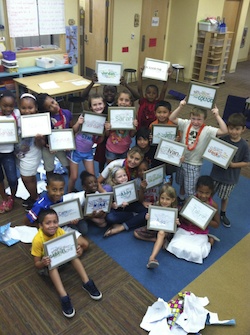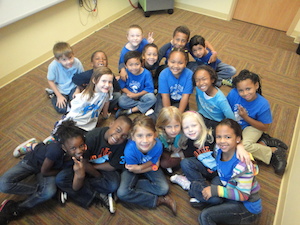Last school year, I left the classroom to take on a teacher leader role at my school. I still worked with students daily, but a lot of my work focused on helping to guide the kindergarten and first grade teachers on my team. While I felt confident about the content of K-1, my adult learners were more than a little intimidating. Some had taught longer than me, some were resistant to having me in their teaching spaces, and some were unsure of what my role really involved. We began our school year feeling the normal level of August stress. Knowing that teachers need time to set up for students, I didn’t want to steal their precious pre-planning time with lots of meetings. So, we jumped in and did our best. However, as the year progressed, we struggled to find our roles on the team, grappled with how to be honest with each other when disagreements arose, and more than one team member would sit silently at meetings feeling out-of-place. I spent the whole year wracking my brain trying to figure out what went wrong. We could go to Happy Hour on a Friday and have a blast laughing, but when it came to working collaboratively, things were simply falling flat.Things really changed for me (and our team) this summer. As I attended the Collaborative Classroom Institute and began focusing the team’s professional learning on building classroom community for our students, I realized where I had gone wrong! In my decade of teaching five-, six-, and seven-year-olds, I never once neglected to start a day without a morning meeting and had never forgotten about the importance of connecting with learners in the first six weeks of school. However, when I began working with adults, I had never once taken the time to give my teammates time to share and open up with each other in the workplace. We were expected to trust each other to critique our work, offer suggestions, and problem-solve, yet we didn’t really know each other! A light bulb had gone off!So, in kicking off this school year, I have made it a mission to build a community of adult learners within my team. We began our work in late July. I invited the team to my house to work. The change of venue meant we could see each other in a new light. We could work together without worrying about our learning spaces being ready to teach or if there was a pile of papers to organize.We began our day gathered in my sunroom, sitting on the floor in a circle. We followed the Responsive Classroom Morning meeting procedures. We each greeted each other by shaking out the syllables of our names on maracas; we shared fun summer memories; we got up and got moving around the room with a quick game; and we ended the meeting by me sharing the goals for the day. This was it-I was back in my element! I know how to teach, and I realized that adults were the same as my kindergartners. They will work much better together if the time is given to them to know, trust, and love each other.
We began our school year feeling the normal level of August stress. Knowing that teachers need time to set up for students, I didn’t want to steal their precious pre-planning time with lots of meetings. So, we jumped in and did our best. However, as the year progressed, we struggled to find our roles on the team, grappled with how to be honest with each other when disagreements arose, and more than one team member would sit silently at meetings feeling out-of-place. I spent the whole year wracking my brain trying to figure out what went wrong. We could go to Happy Hour on a Friday and have a blast laughing, but when it came to working collaboratively, things were simply falling flat.Things really changed for me (and our team) this summer. As I attended the Collaborative Classroom Institute and began focusing the team’s professional learning on building classroom community for our students, I realized where I had gone wrong! In my decade of teaching five-, six-, and seven-year-olds, I never once neglected to start a day without a morning meeting and had never forgotten about the importance of connecting with learners in the first six weeks of school. However, when I began working with adults, I had never once taken the time to give my teammates time to share and open up with each other in the workplace. We were expected to trust each other to critique our work, offer suggestions, and problem-solve, yet we didn’t really know each other! A light bulb had gone off!So, in kicking off this school year, I have made it a mission to build a community of adult learners within my team. We began our work in late July. I invited the team to my house to work. The change of venue meant we could see each other in a new light. We could work together without worrying about our learning spaces being ready to teach or if there was a pile of papers to organize.We began our day gathered in my sunroom, sitting on the floor in a circle. We followed the Responsive Classroom Morning meeting procedures. We each greeted each other by shaking out the syllables of our names on maracas; we shared fun summer memories; we got up and got moving around the room with a quick game; and we ended the meeting by me sharing the goals for the day. This was it-I was back in my element! I know how to teach, and I realized that adults were the same as my kindergartners. They will work much better together if the time is given to them to know, trust, and love each other. Now, each time we gather as a team, we always begin with some sort of group meeting. For all of our team members, it’s a time to learn more about each other. For the new teachers on the team, it’s a time to build up their repertoire of greetings and activities. For our veteran teachers, it’s a time to share their knowledge and welcome others into the profession and our school.I look forward to continuing to implement group meetings with my team in the coming school year. I feel that is the best way for us to build trust and, with that trust, strong working relationships!For further reading, check out my list of community builders we have tried, and please share some of your own! What has gotten your team members up, moving, sharing, and laughing?
Now, each time we gather as a team, we always begin with some sort of group meeting. For all of our team members, it’s a time to learn more about each other. For the new teachers on the team, it’s a time to build up their repertoire of greetings and activities. For our veteran teachers, it’s a time to share their knowledge and welcome others into the profession and our school.I look forward to continuing to implement group meetings with my team in the coming school year. I feel that is the best way for us to build trust and, with that trust, strong working relationships!For further reading, check out my list of community builders we have tried, and please share some of your own! What has gotten your team members up, moving, sharing, and laughing?
Community Builders
Who’s On My Back?
- Have each team member write the name of a person on a post-it note. You can select a specific theme to meet your team’s needs. For example, we all selected favorite children’s book character.
- Next, mix through the room to music, keeping your post-it hidden from others. When the music stops, find a partner and place the post-it on his or her back.
- Finally, team members circulate, asking others questions about the name on their backs. The questions can only be yes or no questions.
- Once a player figures out the name, he or she sits down, but can continue answering questions for others.
- The game continues until every player has figured out “Who’s on my back?”
Would You Rather?
- Purchase a deck of “Would You Rather?” cards and use them as quick brain breaks or get-to-know you activities during a meeting.
- For example, each person could pull a card and ask their favorite question off the card before a meeting starts.
Letters of Recognition
- Once the school year begins and teachers are working closely together, have one person write a letter to another teammate each week, acknowledging the hard work and dedication they have shown.
- These letters can be combined in a journal and passed along, or they can be individually typed and displayed in your work space.
- This is very effective at helping teachers to feel the power of their work and the appreciation of their colleagues.
Deserted Island
- Have team members share out the three people they would like to have with them on a deserted island and why.
- Create different themes for the sharing-for example, who would you want for survival purposes, who would you want because of personal bonds, which famous people would you choose, which book characters would you choose?
- Each week a new teammate can come up with the deserted island theme!
Two Truths and A Lie
- Have each member of the team write down two truths and a lie on a paper or post-it.
- Then, you can have team members share their own post-its and the others try to determine the lie.
- An alternative is to combine all of the truths and lies into one long list and have team members try to figure out what is true about each team member and which items on the list are lies.
